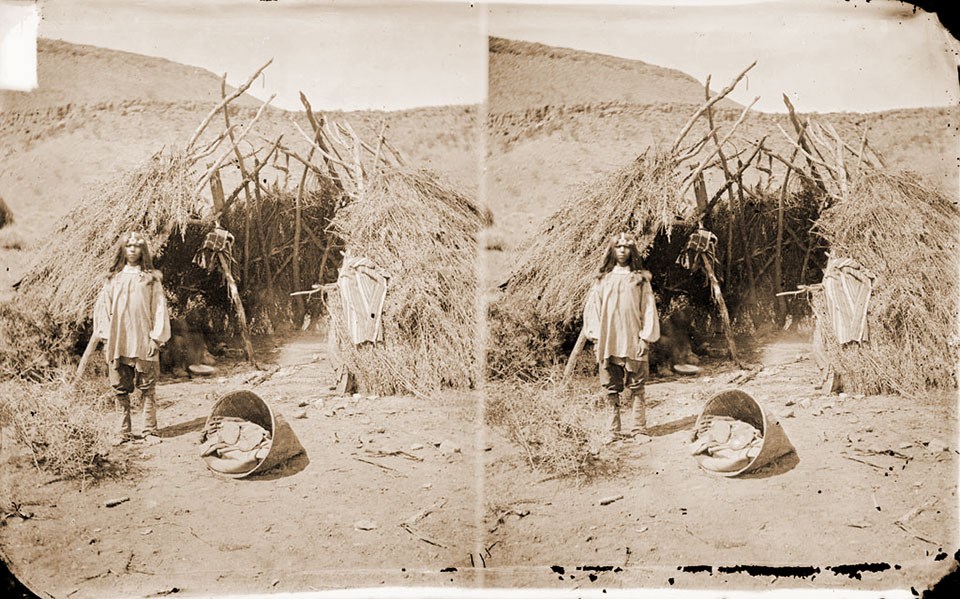Last updated: May 18, 2021
Article
About The Southern Paiute

Digital Image © 2008 Utah State Historical Society. All Rights Reserved.
Wunuh suh’ uh’ hunt
(Sounds like “Wah-new sue oo hunt”)
Paiute for “Standing Strong”
The Southern Paiute have called the desert southwest home for at least as far back as 1100 A.D.
“Paa” ute means water ute, and refers to their preference for living near water sources. These “water utes” lived nomadically and traveled to various areas throughout the year to harvest food and natural materials in the appropriate seasons.
During spring, the Southern Paiute practiced floodplain gardening, creating reservoirs and irrigation ditches to water corn, squash, melons, gourds, sunflowers, beans and wheat.
The Spanish explorer Escalante kept detailed journals of his travels in the Southwest and made notes concerning Southern Paiute horticulture, writing in 1776, that there were “well dug irrigation ditches” being used to water small fields of corn, pumpkins, squash, and sunflowers. Water was the crucial element to traditional Paiute life-ways and subsistence strategies. In the 1850s, when Mormon settlement of southern Utah began, it was through water-access-denial that the Southern Paiutes began being marginalized.
After planting their fields in the spring, the Paiute often journeyed up in elevation (10,000 ft.+) to lush meadows and cool forests. In the refreshing high-country, the Southern Paiute gathered berries and plants, hunted mule deer, elk, bighorn sheep, antelope, woodchucks, and rabbits. They also collected agate, a type of rock used for making stone tools. Their skill at making these tools was widely known and respected, and their arrowheads, spear points and more were traded with many surrounding tribes.
Southern Paiutes were also, and still are, skilled basket weavers. They used their handwoven baskets to carry seeds, roots, tubers, berries, and nuts. When sealed with pine pitch, the finely woven baskets carried water. Other forms of production included the making of bow and arrow; nets; sandals; cordage; lightweight bark skirts and leggings; buckskin and other hide dresses, shirts and breechcloths; and rabbit skin leggings, ropes, blankets and capes.
In spite of hardship, southern Paiute tribes remain. Today, the tribal bands pursues various economic development projects to ensure sustainability and cultural preservation for future generations. They also continue to celebrate through dancing and games at annual tribal gatherings.
Their tradition as storytellers also continues. Elders who still speak the language pass tribal history down to the next generation of Paiute, through a variety of community activities and events. The Southern Paiute are standing strong. Yesterday, today and tomorrow...
Projects through the Tribal Heritage Grant Program have assisted Southern Paiute Tribes in protecting and promoting their cultural heritage and traditions since 2016. The Paiute Tribe of Pyramid Lake, Nevada, were awarded funds to conduct ethnographic surveys of sacred sites in 2016. The Bishop Paiute Tribe of California were awarded funds in 2018 to develop exhibits highlighting tribal interpretation of land and plant resources at the Owens Valley Paiute-Shoshone Cultural Center. The Burns Paiute Tribe of Oregon recieved funding in 2020 to conduct oral history interviews with tribal member elders and produce books focusing on the individual elders interviewed and the events leading to federal recognition for the Tribe.
Tags
- cedar breaks national monument
- colorado national monument
- grand canyon national park
- pipe spring national monument
- timpanogos cave national monument
- zion national park
- paiute
- southern paiute
- american indian heritage
- telling all american stories
- utah
- utah prehistory
- native american
- indigenous peoples
- native american history
- native american heritage
- native american heritage month
- american indian history
- american indian
- historic preservation fund
- historic preservation grants
- tribal heritage
